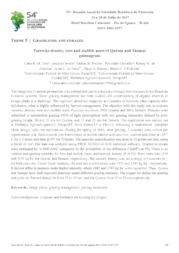Tussocks density, root and stubble mass of Quênia and Tamani guineagrass.
Tussocks density, root and stubble mass of Quênia and Tamani guineagrass.
Author(s): TESK, C. R. M.; CAVALLI, J.; PEREIRA, D. H.; CARVALHO, P.; ALMEIDA, R. M. de; FARIA, A. C. de; RAMOS, T. A.; PEDREIRA, B. C. e
Summary: The forage use in animal production is functional and can be consider a strongly feed resource in the Brazilian livestock systems. Since grazing management has been studied, the understanding of organic reserves in forage plants is a challenge. The regrowth speed and longevity are function of recovery plant capacity after defoliation, what is highly influenced by harvest management. The objective with this study was to evaluate tussocks density, root and stubble mass Panicum maximum BRS Quenia and BRS Tamani. Pastures were submitted to intermittent grazing (95% of light interception) with two grazing intensities defined by postgrazing height: 20 and 35 cm for Quenia, and 15 and 25 cm for Tamani. The experiment was carried out at Embrapa Agrossilvipastoril, Sinop/MT, from March/15 to Dez/16, following a randomized complete block design, with tree replications. During the spring of 2016, after grazing, 3 tussocks were collect per experimental unit. Each tussock was fractionated in stubble (above soil) and root, washed and dried at 105 ° C for 1.5 hours and later at 55° for 72 hours. The tussocks quantification was done in 10 points per plot, using a frame of 1m². The data was analyzed using PROC MIXED of SAS statistical software. Treatments means were estimated by ?LSMEANS? compared by the probability of the difference (?pdiff?) at 5%. There is no cultivar and grazing intensity for root and stubble mass, and tussock density (P>0.05). Root mass was 1590 and 1915 kg ha-1 for Quenia and Tamani, respectively. The tussock density was, an average, 6.9 tussocks m-2, for both cultivars. Under lower intensity, the root and stubble mass were 1826 and 1293 kg ha-1, respectively. It did not differ in pastures under higher intensity, where 1683 and 1747 kg ha-1 were registered. Thus, Quenia and Tamani have well regrowth potential under different grazing intensity. The trigger for define the grazing end point for Tamani should be from 25 to 15 cm, and for Quenia from 35 to 20 cm,respectively.
Publication year: 2017
Types of publication: Abstract in annals or event proceedings
Keywords: Forage, Forage plants, Grazing intensities, Grazing management
Observation
Some of Embrapa's publications are published as ePub files. To read them, use or download one of the following free software options to your computer or mobile device. Android: Google Play Books; IOS: iBooks; Windows and Linux: Calibre.
Access other publications
Access the Agricultural Research Database (BDPA) to consult Embrapa's full library collection and records.
Visit Embrapa Bookstore to purchase books and other publications sold by Embrapa.

